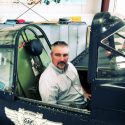
Ralph Goldman was born in Iwaniska, Poland on July 25, 1921. He came to Canada as an infant, early in the 1920s, and he grew up in down-town Toronto against the backdrop of the Great Depression. The economic situation forced him to leave school when he was only 14, and he went to work to help support his family.
His recollections of that time are vivid, from the Christopher House welcome centre and summer camp to 4AM deliveries with his father to life in the hardware store, where he met many of the men and women who would be important later in life.
With the coming of the war, Ralph joined up alongside so many other young men in Canada; coming from a Polish Jewish family he was more motivated than most. Ralph chose to go into the RCAF, and he began his training and became a ground crew mechanic serving in Bomber Command.

Ralph went overseas early in the war, and spent several years in England, working to keep the planes and crews of Squadron 415 in the air. The squadron had formed in August 1941 on RAF Thorney Island as Canada’s first Torpedo Bombing Squadron.
Operating the twin engined Handley Page Hampden the squadron flew its first operational mission on 21 April 1942. Over the next two years the Squadron would fly anti-submarine and anti-shipping patrols in the English Channel and Bay of Biscay[1]https://www.canada.ca/en/air-force/corporate/squadrons/415-squadron.html.
On Thorney Island Ralph performed many tasks, from guard duty to maintaining the beaches of the Island. He recalls the accommodations and food being exceptional, setting a standard that he did not see anywhere else through the war.
In 1943 the squadron would change aircraft to the Vickers Wellington and Fairey Albacore replacing the Hampden’s. Operating out of RAF Bircham Newton they became very effective against German E-boats (fast attack crafts) in the English Channel; the Wellingtons employed to find the E-boats while the Albacores were sent to attack them.
Working on the engines of the big planes Ralph took several courses to improve his expertise on the way. By July 1944 the squadron had been re-equipped with the four-engined Handley Page Halifax bomber and relocated to RCAF Station East Moor in Yorkshire. From here the Squadron flew over 100 bomber missions over Germany until its final wartime one on 25 April 1945[2]http://www.415sqn.com/history.html.



During his time deployed to UK he was also was able to see a bit of England, venturing into the dance halls and pubs of London and Edinburgh. At war’s end he returned to Canada, going back to school and marrying and starting his life in the new rhythms of postwar Toronto.
Ralph Goldman was interviewed by Scott Masters for the Crestwood Oral History Project in his home in Toronto 22 May 2022. The first part of his interview can be seen at the bottom of this page while the rest can be seen on Crestwood Oral History website.
On this occasion, where also Jack Reid signed, Mr Goldman added his name to a page in The Log Book.





References





Be the first to comment